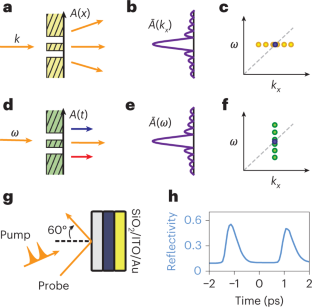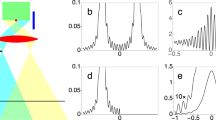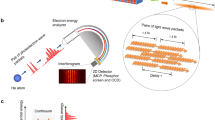Abstract
Double-slit experiments—where a wave is transmitted through a thin double aperture in space—have confirmed the wave–particle duality of quantum objects, such as single photons, electrons, neutrons, atoms and large molecules. Yet, the temporal counterpart of Young’s double-slit experiment—a wave interacting with a double temporal modulation of an interface—remains elusive. Here we report such a time-domain version of the classic Young’s double-slit experiment: a beam of light twice gated in time produces an interference in the frequency spectrum. The ‘time slits’, narrow enough to produce diffraction at optical frequencies, are generated from the optical excitation of a thin film of indium tin oxide near its epsilon-near-zero point. The separation between time slits determines the period of oscillations in the frequency spectrum, whereas the decay of fringe visibility in frequency reveals the shape of the time slits. Surprisingly, many more oscillations are visible than expected from existing theory, implying a rise time that approaches an optical cycle. This result enables the further exploration of time-varying physics, towards the spectral synthesis of waves and applications such as signal processing and neuromorphic computation.
This is a preview of subscription content, access via your institution
Access options
Access Nature and 54 other Nature Portfolio journals
Get Nature+, our best-value online-access subscription
$29.99 / 30 days
cancel any time
Subscribe to this journal
Receive 12 print issues and online access
$209.00 per year
only $17.42 per issue
Buy this article
- Purchase on Springer Link
- Instant access to full article PDF
Prices may be subject to local taxes which are calculated during checkout


Similar content being viewed by others
Data availability
Source data are available for this paper and are available via a public repository at https://doi.org/10.6084/m9.figshare.21968435. All other data that support the plots within this paper and other findings of this study are available from the corresponding authors upon request.
Change history
11 April 2023
In the version of this article initially published, x-axis labels were omitted for Figure 2e, which are now restored in the HTML and PDF versions of the article.
References
Moshinsky, M. Diffraction in time. Phys. Rev. 88, 625–631 (1952).
Felber, J., Müller, G., Gähler, R. & Golub, R. Time dependent neutron optics: II. Diffraction in space and time. Phys. B: Condens. Matter 162, 191–196 (1990).
Szriftgiser, P., Guéry-Odelin, D., Arndt, M. & Dalibard, J. Atomic wave diffraction and interference using temporal slits. Phys. Rev. Lett. 77, 4–7 (1996).
Brukner, C. & Zeileinger, A. Diffraction of matter waves in space and in time. Phys. Rev. A 56, 3804–3824 (1997).
Galiffi, E. et al. Photonics of time-varying media. Adv. Photon. 4, 014002 (2022).
Zhou, Y. et al. Broadband frequency translation through time refraction in an epsilon-near-zero material. Nat. Commun. 11, 2180 (2020).
Bruno, V. et al. Broad frequency shift of parametric processes in epsilon-near-zero time-varying media. Appl. Sci. 10, 1318 (2020).
Bohn, J., Luk, T. S., Horsley, S. & Hendry, E. Spatiotemporal refraction of light in an epsilon-near-zero indium tin oxide layer: frequency shifting effects arising from interfaces. Optica 8, 1532–1537 (2021).
Vezzoli, S. et al. Optical time reversal from time-dependent epsilon-near-zero media. Phys. Rev. Lett. 120, 043902 (2018).
Kinsey, N., DeVault, C., Boltasseva, A. & Shalaev, V. M. Near-zero-index materials for photonics. Nat. Rev. Mater. 4, 742–760 (2019).
Alam, M. Z., De Leon, I. & Boyd, R. W. Large optical nonlinearity of indium tin oxide in its epsilon-near-zero region. Science 352, 795–797 (2016).
Tirole, R. et al. Saturable time-varying mirror based on an epsilon-near-zero material. Phys. Rev. Applied 18, 054067 (2022).
Bohn, J. et al. All-optical switching of an epsilon-near-zero plasmon resonance in indium tin oxide. Nat. Commun. 12, 1568 (2021).
Un, I. W., Sarkar, S. & Sivan, Y. An electronic-based model of the optical nonlinearity of low density Drude materials. Preprint at https://arxiv.org/abs/2210.08504 (2022)
Sounas, D. L. & Alù, A. Non-reciprocal photonics based on time modulation. Nat. Photon. 11, 774–783 (2017).
Koutserimpas, T. T. & Fleury, R. Nonreciprocal gain in non-Hermitian time-Floquet systems. Phys. Rev. Lett. 120, 087401 (2018).
Galiffi, E., Huidobro, P. & Pendry, J. B. Broadband nonreciprocal amplification in luminal metamaterials. Phys. Rev. Lett. 123, 206101 (2019).
Lerosey, G. et al. Time reversal of electromagnetic waves. Phys. Rev. Lett. 92, 193904 (2004).
Bruno, V. et al. Negative refraction in time-varying strongly coupled plasmonic-antenna–epsilon-near-zero systems. Phys. Rev. Lett. 124, 043902 (2020).
Lustig, E., Sharabi, Y. & Segev, M. Topological aspects of photonic time crystals. Optica 5, 1390–1395 (2018).
Dutt, A. et al. A single photonic cavity with two independent physical synthetic dimensions. Science 367, 59–64 (2020).
Cronin, D., Schmiedmayer, J. & Pritchard, D. E. Optics and interferometry with atoms and molecules. Rev. Mod. Phys. 81, 1051–1129 (2009).
del Pino, J., Slim, J. J. & Verhagen, E. Non-Hermitian chiral phononics through optomechanically induced squeezing. Nature 606, 82–87 (2022).
Fleury, R., Sounas, D. L., Sieck, C. F., Haberman, M. R. & Alù, A. Sound isolation and giant linear nonreciprocity in a compact acoustic circulator. Science 343, 516–519 (2014).
Cho, C., Wen, X., Park, N. & Li, J. Digitally virtualized atoms for acoustic metamaterials. Nat. Commun. 11, 251 (2020).
Nagulu, A., Reiskarimian, N. & Krishnaswamy, H. Non-reciprocal electronics based on temporal modulation. Nat. Electron. 3, 241–250 (2020).
Schultheiss, K. et al. Time refraction of spin waves. Phys. Rev. Lett. 126, 137201 (2021).
Acknowledgements
E.G. acknowledges support from the Simons Foundation (855344). R.S., S.V., J.B.P. and S.A.M. acknowledge support from UKRI (EP/V048880). J.B.P. acknowledges support from the Gordon and Betty Moore Foundation. S.A.M. acknowledges the Lee-Lucas Chair in Physics.
Author information
Authors and Affiliations
Contributions
Conceptualization: R.S., S.V., J.B.P., R.T. and E.G. Methodology: S.V., R.T., R.S., E.G. and J.B.P. Software: R.T., I.R., D.M. and E.G. Investigation: R.T., S.V., I.R., D.M. and E.G. Visualization: R.T., R.S., I.R. and D.M. Funding acquisition: R.S., J.B.P., S.A.M. and S.V. Project administration: R.S., J.B.P. and S.A.M. Supervision: R.S. and J.B.P. Writing (original draft): R.S., J.B.P., S.V., R.T. and E.G. Writing (review and editing): R.S., J.B.P., S.V., R.T., E.G., S.A.M. and B.T.
Corresponding authors
Ethics declarations
Competing interests
The authors declare no competing interests.
Peer review
Peer review information
Nature Physics thanks Humeyra Caglayan and Francisco Rodríguez-Fortuño for their contribution to the peer review of this work.
Additional information
Publisher’s note Springer Nature remains neutral with regard to jurisdictional claims in published maps and institutional affiliations.
Extended data
Extended Data Fig. 1 Characterization of the temporal double slit with a short (225 fs) probe pulse.
a, Experimental intensity reflectivity (blue line) for a 2.3 ps separation between the time slits, as a function of the probe delay. This is fitted with the model in Fig. S2A (dashed red line). b, Reflectivity for a linear variation of the slit separation (horizontal axis) measured as a function of the probe delay with one of the pumps (vertical axis). c, Intensity dependence of the maximum achievable reflectivity for the two time slits driven by pump 1 (incident at 54°) and pump 2 (incident at 66°). The reflectivity saturates reaching a maximum value of 0.6.
Extended Data Fig. 2 Modelled reflection coefficient.
a, Amplitude reflection coefficient r(t) corresponding to a realistic modulation of the time-varying mirror (see Fig. S3A). b, Amplitude reflection coefficient in the asymptotic limit.
Extended Data Fig. 3 Comparison of the models against experimental data.
a–c, Signal against frequency and slit separation for experiment (a), the time diffraction model (b) and the adiabatic, dispersive time-varying model (c). The plots are color-saturated to ensure a fair quantitative comparison between the fringe visibility of the respective datasets. d, Experimental oscillation spectrum on a logarithmic scale at a slit separation of 800 fs compared to the theoretical one for various material response times.
Supplementary information
Supplementary Information
Supplementary figs. 1–4.
Source data
Source Data Fig. 1
Measured data.
Source Data Fig. 2
Measured data, smoothed data and modelling.
Source Data Extended Data Fig. 1
Measured data.
Source Data Extended Data Fig. 2
Modelling.
Source Data Extended Data Fig. 3
Measured data, smoothed data and modelling.
Rights and permissions
Springer Nature or its licensor (e.g. a society or other partner) holds exclusive rights to this article under a publishing agreement with the author(s) or other rightsholder(s); author self-archiving of the accepted manuscript version of this article is solely governed by the terms of such publishing agreement and applicable law.
About this article
Cite this article
Tirole, R., Vezzoli, S., Galiffi, E. et al. Double-slit time diffraction at optical frequencies. Nat. Phys. 19, 999–1002 (2023). https://doi.org/10.1038/s41567-023-01993-w
Received:
Accepted:
Published:
Issue Date:
DOI: https://doi.org/10.1038/s41567-023-01993-w
This article is cited by
-
Thermo-optic epsilon-near-zero effects
Nature Communications (2024)
-
Non-local temporal interference
Scientific Reports (2024)
-
Acousto-optic modulation of gigawatt-scale laser pulses in ambient air
Nature Photonics (2024)
-
Unconventional light - matter interaction in the response-time region of unionized bound electrons
Applied Physics B (2024)
-
An optical double-slit experiment in time
Nature Physics (2023)



